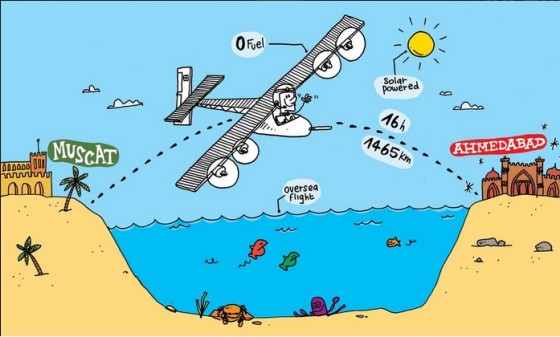— Shashwat DC
Solar Impulse 2 has landed in India, at the Ahmedabad Airport. It will spend two days in India, with the highlight being its flight over the Ganges river in Varanasi, where it will promote the green message. While, it is here, let’s take a look at some of the most fascinating aspects of the solar-powered plane.
1) Solar Impulse 2 is a second prototype to the first one, namely, Solar Impulse 1. The first test flight was conducted in December 2009, and first flew  an entire diurnal solar cycle, including nearly nine hours of night flying, in a 26-hour flight on 7–8 July 2010. Solar Impulse 1 has already flown across the United States, storing enough energy from the sun to fly overnight. Solar Impulse 2 is now attempting to become the first solar powered flight to travel around the globe. It will fly for 25 days, over 5 months, all the way around the Earth.
an entire diurnal solar cycle, including nearly nine hours of night flying, in a 26-hour flight on 7–8 July 2010. Solar Impulse 1 has already flown across the United States, storing enough energy from the sun to fly overnight. Solar Impulse 2 is now attempting to become the first solar powered flight to travel around the globe. It will fly for 25 days, over 5 months, all the way around the Earth.
2) 12 stops are planned to allow the alternation of pilots Bertrand Piccard and André Borschberg, and the plane is expected to cruise at between 50 and 100 kilometres per hour – usually at the slower end of that range at night to save power. The departure and arrival point are set to be Abu Dhabi. Its maximum cruising altitude of 27,000 ft. is only slightly lower than the 30,000-40,000 ft. altitude of most commercial airplanes.
3) The craft has a huge wingspan equal to that of an Airbus A340, and its proportionally tiny weight. The single-seater aircraft made of carbon fibre has a 72 meter wingspan for a weight of just 2,300 Kg, a little more than that of a Toyota Fortuner.
4) Across the wings, fuselage, and horizontal tail, 17, 248 solar cells (as thick as human hair) collect up to 340 kilowatt per day, (the average an Indian home uses in a month). The super-wide wings allow it to take advantage of air currents to glide without the need for much power.
5) A 235-kg lithium battery is mounted with each of the motors. Together, the batteries account for around 25% weight of the aircraft.
6) Four electric motors, each driving a two-blade propeller, are mounted below the wings. Each averages 15 horsepower (similar to that of a motor boat). Over an optimum 24-hour cycle, the motors can deliver a combined average of about 8 HP (6 kW), roughly the power used by the Wright brothers’ Flyer, the first successful powered aircraft, in 1903
 7) The Solar Impulse 2 can fly through rain, and its solar cells harvest power even on cloudy days. During the voyage, a mission control team headquartered in Monaco will track the plane and provide the pilot with weather forecasts and options for avoiding turbulence and storms. The plane’s path has been chosen carefully, planning the route for maximum summer sunshine, short nights, and shiny, happy weather.
7) The Solar Impulse 2 can fly through rain, and its solar cells harvest power even on cloudy days. During the voyage, a mission control team headquartered in Monaco will track the plane and provide the pilot with weather forecasts and options for avoiding turbulence and storms. The plane’s path has been chosen carefully, planning the route for maximum summer sunshine, short nights, and shiny, happy weather.
8) Some flights over the Pacific and the Atlantic will last five to six days. Inside the cockpit (with advanced avionics that also has an auto-pilot), a specially made thermal foam is used to control the temperature – and that has already been used in some fridges. Also, aboard the single-seat aircraft will be six oxygen tanks, one parachute and a life raft. The 12.5 cubic foot single cockpit is smaller than a sedan’s trunk. The pilot’s seat functions as both a reclining bed and a toilet.
9) More than a 100 sponsors for the project, the major ones being SwissCom, Toyota, ABB, Google and Omega. Cost of Solar Impulse, so far around Rs. 1000 crores have been spent by the inventors Bertrand Piccard and André Borschberg. Remember the Mangalyaan Mission to Mars had been achieved at half the cost, around Rs. 450 crores.
10) The Indian connect, Borschberg’s personal instructor is Sanjeev Bhanot, who has created a yoga and meditation module (including self-hypnosis) to be employed during flight to help the pilots remain mentally and physically well. Their vital signs will also be monitored from a mission control centre in Monaco.










Recent Comments